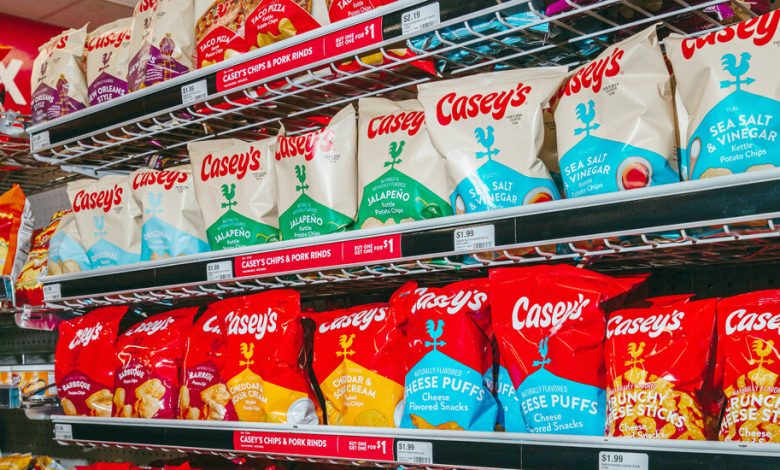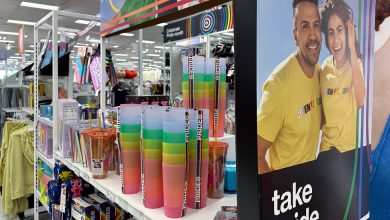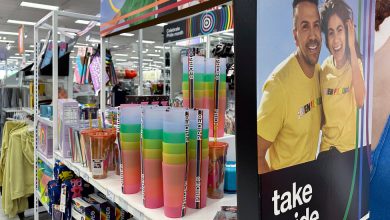Those Doritos Too Expensive? More Stores Offer Their Own Alternatives.

The snack chips had become pretty pricey.
For years, customers stopping at Casey’s General Stores, a convenience store chain in the Midwest, hadn’t thought twice about snagging a soda and a bag of Lay’s or Doritos chips. But over the past year, as the price of a bag of chips soared and some customers felt squeezed by the high cost of gas and other expenses, they began picking up Casey’s less-expensive store brand.
So Casey’s began stocking more of its own chips, in a variety of new flavors. This summer, Casey’s brand made up a quarter of all bags of chips sold, eating into the sales of big brands like Frito-Lay, which is owned by PepsiCo.
“As inflation continues to ratchet up, more people are open to trying alternatives,” said Darren Rebelez, the chief executive of Casey’s, which has 350 private-label products and plans to add 45 this year. “If you put the alternative right on the shelf, right next to the expensive option, people may say, ‘What the heck,’ and give it a try.”
Large food companies gobbled up market share during the pandemic. With supply chain issues affecting what was on the shelves, people were buying basically whatever they could find. And they kept buying even as prices soared when the food and beverage brands raised prices to maintain their profit levels while still covering rising ingredient and labor costs.
But with retailers now expanding their store-owned food and beverage offerings, consumers are slowly shifting their spending. Overall, private-label foods and beverages have crept up to a 20.6 percent share of grocery dollars from 18.7 percent before the pandemic, according to the market research firm Circana.
But a deeper look at some categories reveals private-label goods are gaining significant ground on national brands. Private labels snagged 38 percent of canned vegetable sales in the three months that ended June 30, according to Numerator, another market research firm. Numerator’s data also shows private-label cheese held 45 percent of the market and coffee nearly 15 percent.
The shift in spending reflects a customer base that is nearing or at its tipping point. Inflation, which climbed to 3.7 percent in September, is running at a less-rapid pace than a year ago, but millions of shoppers still face increasingly high prices in grocery stores.
The trend is having a greater effect among those with lower incomes, who spend a greater share of their paycheck on food, even as a pandemic-era policy that increased the amount of money that food-stamp recipients received over the last three years has ended. This month, payments on federal student loans, which had been on pause for the pandemic, also resumed. Adding to the financial burden, rates on credit cards and mortgages are rising.
Two-thirds of consumers said in July that they bought less-expensive groceries at retailers, an increase of four percentage points from a year earlier, according to the consulting firm McKinsey. The shift, the firm said, was particularly pronounced among those with incomes less than $100,000 in categories such as meat, dairy and staples.
“Consumers are trading down,” said Rupesh D. Parikh, an equity analyst at Oppenheimer & Company who covers food, grocery and consumer products. He recently bought a box of Kellogg’s Mini Wheats cereal at Walmart along with the Walmart version. “The Kellogg’s cereal was 75 percent more expensive, and I couldn’t tell the difference between them,” he said.
Big brands, in response, are already starting to offer small sale prices on certain foods, like salty snacks. “The question is how deep they are willing to go in promotions,” Mr. Parikh said.
The expansion in private-label goods is also a response to a changing grocery landscape. Competition is revving up because of consolidation, led by Kroger’s proposed $24.6 billion merger with Albertsons, and the push into the United States by entrants like the German discount chain Aldi, which stocks 90 percent of its shelves with private-label goods. In August, Aldi agreed to acquire 400 Winn Dixie and Harveys Supermarket stores, giving it a significant presence in the Southeast.
Retailers say they need the private-label goods to give consumers a broader array of choices. The store brands are also typically more profitable for the retailers than products from big food companies.
But perhaps the biggest factor is a seismic shift in consumer attitudes. Older generations that grew up with “generic” ketchup or soup recall them as bland, tasteless versions of the name brands. Retailers, which have dumped the term “generic,” insist that the quality of the private-label foods and beverages has improved substantially. Social media platforms like TikTok and Reddit are filled with young people hyping their favorite store brand foods at Aldi and Trader Joe’s.
“If the food is not good quality, our reputation is at risk,” said Scott Patton, the vice president of national buying for Aldi, who said the chain was seeing increased traffic in all income levels. “If you’re going to sell a store-branded apple cinnamon ice cream, it had better be the best apple cinnamon ice cream you’ve ever had.”
Retailers are offering customers “belly fillers,” basic foods at low prices that are virtual clones of national brands, but they are also hunting for ways to differentiate themselves, said Jordan Bouey, the owner of Silver State Baking, a Las Vegas-based manufacturer that makes cookies, bars and breads for grocery chains and retailers.
“If there’s a category that doesn’t have a big national brand, retailers are looking to be unique and give the shoppers what they’re looking for, like a protein cookie,” Mr. Bouey said.
At a Wegmans in Hanover, N.J., the dried pasta aisle was stocked with fettuccine, shells and spaghetti from well-known brands like Barilla and De Cecco. But the vast majority of the pasta on the shelves was Wegmans’ own brand, one line priced at 99 cents a box and another, Amore, that is imported from Italy and $4.99 a box, about $2 more than some of the national brands.
“We want our brand to serve the value customer who is on a budget,” said Nicole Wegman, who was named president of Wegmans Brand in 2021. Wegmans has expanded its private-label business in recent years to more than 17,000 products, including deli and prepared meals, frozen vegetables and healthy snacks.
“But we also want products, like our cheese and our breads, that are fun for the food enthusiast,” Ms. Wegman said. “They’re specialty items and more expensive to make, so we have to charge more for them.”
Indeed, executives at Casey’s, which started dabbling in private-label goods three years ago, said they were trying not to compete with the national brands but rather expand what’s available for customers. In some cases, that means offering flavors the national brands do not.
Sales of limited-edition Casey’s chips in flavors like sweet corn, barbecue brisket and jalapeño Cheddar sold well this summer. “Those are the kind of products that a Frito-Lay is not going to make because it is not a national flavor profile that is going to work for their business,” Mr. Rebelez said.
But he also acknowledged that some Casey’s customers were simply looking for deals.
Take candy bars. For years, retailers would not compete against behemoths like Hershey and Mars because customers remained loyal to the brands they had grown up eating. But as the price of candy bars rose in recent years, some customers stopped buying.
So Casey’s created four of its own lower-priced candy bars, including a chocolate with mint and a chocolate caramel.
“I was skeptical going in, but those candy bars have performed really well,” Mr. Rebelez said, adding that Casey’s was working on more iterations. “There is a breaking point for consumers, and in certain products and categories we’ll provide an alternative.”




